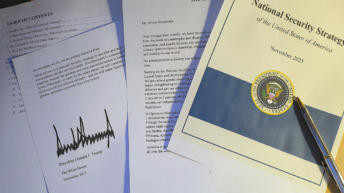
Introduction
On 20 August 2025, India’s Strategic Forces Command successfully test-fired the Agni-5 ballistic missile from Chandipur, Odisha, marking a decisive step towards operational deployment. Following Mission Divyastra’s MIRV (Multiple Independently Targetable Re-entry Vehicle) breakthrough in 2024, the test validated advanced guidance and survivability features, reaffirming India’s emergence as a credible long-range nuclear power. It allows a single missile to release multiple nuclear warheads aimed at different targets, making enemy missile defences harder to counter and strengthening India’s second-strike capability. It takes India significantly closer to having an operational long-range deterrent capable of engaging multiple, widely separated targets simultaneously. It indicates that the Agni-5 is ready for deployment and poised to play a vital role in India’s defence strategy. This achievement enhances India’s stature as a nation capable of ensuring its own security without external support. It marks a major advance in India’s strategic capabilities, setting it apart from earlier versions of the Intercontinental Ballistic Missile (ICBM), chiefly through the successful validation and near-operational deployment of MIRV technology.
What is MIRV?
A MIRV is a ballistic missile payload that allows a single missile to carry several warheads, each capable of hitting a different target. This greatly boosts its offensive power. One missile can perform multiple strikes, overwhelming even the most advanced missile defence systems and providing a credible, destructive deterrent. For India, adding MIRVs to the Agni-5 significantly enhances its second-strike ability, even with a limited arsenal. Officially, Agni-5 is classified as an intermediate-range ballistic missile (IRBM) with a range of 5,000 km, as ICBMs are defined as exceeding 5,500 km. However, many experts believe this underestimates its true range, with credible assessments suggesting it can strike targets up to 8,000 km away—placing it clearly within the intercontinental category. Only a few nations possess this MIRV technology. India is among an exclusive group—United States, United Kingdom, Russia, France, and China—that have mastered it.

Picture Source: https://pwonlyias.com/
The Evolution of India’s Missile Development
India’s pursuit of missile capability began during the Cold War, driven by technology restrictions and international embargoes that led to a reliance on indigenous innovation. In the 1960s, India experimented with sounding rockets under ISRO, laying the groundwork for future propulsion and guidance systems. The 1971 war with Pakistan and the 1974 Pokhran-I nuclear test underscored the need for credible delivery systems. Early efforts, such as Project Devil (an attempt to reverse-engineer the Soviet SA-2) and Project Valiant (an effort to develop an ICBM), did not reach deployment. However, they provided vital lessons in propulsion, aerodynamics, and control technology. A significant turning point occurred in 1983 with the launch of the Integrated Guided Missile Development Programme (IGMDP), led by DRDO under Dr. A.P.J. Abdul Kalam. It produced the Prithvi short-range ballistic missile, the Agni series, the Akash medium-range SAM, Trishul short-range SAM, and the Nag anti-tank missile. Despite sanctions after 1998, the DRDO advanced propulsion, navigation, re-entry technology, and canisterisation. By the end of IGMDP in 2008, India had established a strong missile foundation.
From there, the focus shifted to operational deployment, longer ranges, higher accuracy, and survivability. The Agni series became the backbone of India’s deterrent—beginning with Agni-I (700–900 km) and Agni-II (~2,000 km), extending through Agni-III and IV (3,500–4,000 km), and culminating in Agni-5 (~5,000 km). Each successful launch reinforces India’s status as a significant missile power—ready, responsible, and resolute in defence. Agni-5 represents a substantial advance, employing a three-stage solid-propellant design with road mobility and canister launch capability, ensuring both readiness and survivability. With a 1.5-tonne payload and advanced guidance supported by NavIC and GPS, it offers pinpoint accuracy. In 2024, India successfully demonstrated MIRV technology, enabling one missile to strike multiple targets—an elite global capability.
The maturity of the development process is clear from its milestones: the maiden test in 2012, pre-induction trials by 2018, a successful user trial in 2021, a nighttime test in 2022 confirming a range of over 7,000 km, and ultimately, the MIRV breakthrough in 2024. Complementing the Agni series, the K-series SLBMs (K-15, K-4) armed Arihant-class SSBNs complete the nuclear triad. The BrahMos supersonic cruise missile, co-developed with Russia, offers a precision-strike advantage, while indigenous Nirbhay/ITCM expands its long-range subsonic capabilities. India’s entry into the Missile Technology Control Regime (MTCR) in 2016 reinforced its position as a responsible missile power.
With hypersonic glide vehicle trials (HSTDV – Hypersonic Technology Demonstrator Vehicle) and the integration of MIRVs on Agni-5, India continues to push technological frontiers. From tentative experiments in the 1970s to today’s advanced arsenal, India’s missile journey reflects its determination to achieve self-reliance and secure a credible, future-ready strategic deterrent.

Shaping an Indigenous Defence Ecosystem
What makes these achievements particularly significant is the way they were accomplished. For decades, India has steadily moved towards self-reliance in defence. The active involvement of DRDO, Bharat Dynamics Limited, Bharat Electronics Limited, and the private sector shows the development of a comprehensive ecosystem capable of designing and manufacturing advanced weapon systems. Instead of relying on imports, India is now developing indigenous solutions, with direct feedback from the armed forces quickly incorporated into design improvements tailored to operational requirements.
The development of Akash Prime exemplifies this approach. Incorporating user-suggested improvements, it was thoroughly tested in real battlefield conditions and is now fully prepared for induction into the Army. Such collaboration ensures that systems are not only technologically advanced but also practical and tailored to soldiers’ needs.
This model offers valuable lessons beyond India. For regions like the Middle East, developing local industries, fostering collaborations between public and private sectors, and addressing the actual needs of the armed forces represent the most effective way to build reliable defence capabilities. India’s experience shows how countries can lower reliance on imports while strengthening their own defence industries.
India’s Strategic Position and the Role of Agni-5
Global Nuclear Context. Currently, nine nations are recognised as nuclear-armed states—ranging from the US, Russia, the United Kingdom, France, and China, to regional powers like India, Pakistan, and North Korea—with an estimated total stockpile of around 13,000 warheads. 90% of these belong to the US and Russia alone. China currently has around 400 warheads but is rapidly modernising its arsenal. Pakistan and India each hold an estimated 160 warheads. Large portions of the US, Russian, and Chinese missile forces are already MIRV-capable, with some carrying up to 14 warheads. France, the UK, and Israel also possess MIRV systems, while Pakistan’s Ababeel missile can deliver up to eight small warheads over a 3,500 km range, primarily designed for use against India.
Global Positioning. India now ranks in the middle tier of advanced missile powers—comparable to France, the UK, and Israel—while distinct from both the top-tier ICBM nations and less-developed regional programmes. This positions it well ahead of Pakistan, Iran, and North Korea, whose missile capabilities, although expanding, remain less reliable and technologically inferior. While the United States, Russia, and China operate true ICBMs with ranges exceeding 10,000 km as well as hypersonic systems, India has not yet entered that category. However, with Agni-5—officially rated at 5,000 km but assessed by many experts as nearer to 7,500–8,000 km and MIRV capability—India effectively bridges the credibility gap in Asia by bringing China’s vital political and industrial centres within reach.
Doctrinal Distinctiveness. What sets India apart is not only its capability but also its restraint. Guided by its declared No First Use (NFU) policy and principle of credible minimum deterrence, India avoids destabilising arms races while ensuring assured retaliation and survivability. This posture contributes to regional stability by signalling that India’s arsenal is designed for deterrence, not aggression. India’s 2016 entry into the Missile Technology Control Regime (MTCR) further reflects its alignment with global non-proliferation norms, strengthening its reputation as a responsible power that balances technological ambition with strategic restraint. In essence, India combines strategic restraint, steady technological advancement, and a commitment to responsible deterrence, positioning itself as a key player in shaping the nuclear balance of the 21st century.
Operational Role of Agni-5. Against this backdrop, Agni-5 becomes the core of India’s deterrent framework. Its canistered, road-mobile design ensures survivability and swift launch, while its MIRV capability enables one missile to strike multiple, widely separated targets—overcoming even advanced missile defences. The test-firing of Agni-5 was therefore more than just a technological achievement; it was a strategic signal to adversaries and the world that India is ready to confront evolving threats. For China, it communicates that India is committed to maintaining its strategic balance in Asia. For Pakistan, it underscores the widening technological gap, especially in long-range systems. Simultaneously, Agni-5 underpins a broader missile shield—complementing shorter-range systems like Agni-I and Prithvi-II, tactical systems such as Nag, and layered air defences including Akash Prime and Trishul. Looking ahead, the platform is expected to pave the way for longer-range variants, hypersonic glide vehicles, and upgraded submarine-launched systems, strengthening India’s nuclear triad and securing credible deterrence for the future.
Next Steps in India’s Missile Roadmap
Recent conflicts, from Ukraine to Operation Sindoor, have highlighted the crucial importance of stand-off weapons in modern warfare. Striking well-defended strategic sites and high-value tactical targets requires ballistic and cruise missiles, along with deep-penetration systems capable of overcoming layered defences. Such weapons must combine extensive range, speed, precision, and lethality, while incorporating countermeasures to evade advanced air defence systems.
Agni-5 is more than just a weapon; it signifies India’s readiness for any threat. Consequently, India’s missile development will continue, with upcoming projects like Agni-VI—expected to reach ranges of 8,000–10,000 km and potentially carry 10–12 independent warheads. Planned upgrades also include:
- Penetration aids to overcome increasingly advanced, layered missile defence systems.
- Advanced guidance and targeting systems capable of neutralising well-defended, deeply buried, or mobile enemy assets.
- Enhanced survivability and quick-launch abilities, guaranteeing assured retaliation in a nuclear conflict scenario.
India is also investing in hypersonic glide vehicles (HGVs), directed-energy systems, and next-generation submarine-launched ballistic missiles (SLBMs) to strengthen the credibility of its nuclear triad. Collectively, these initiatives demonstrate India’s commitment to maintaining a robust, flexible, and technologically advanced deterrent—not as an act of aggression but as a foundation for strategic stability and peace through strength.
Meanwhile, India’s doctrine of credible minimum deterrence and No First Use (NFU) continues to distinguish it from powers engaged in arms races. By emphasising survivability, precision, and resilience rather than sheer numbers, India demonstrates strategic maturity and responsible management of advanced technologies.
Conclusion
India’s missile journey, from initial experiments to the advanced Agni-5, reflects a consistent move towards self-reliance, technological progress, and strategic credibility. By successfully integrating sophisticated systems, India has built a layered defence shield that protects its territory and highlights its responsible nuclear stance. Looking ahead, projects like Agni-VI and hypersonic technologies will further boost deterrence and help maintain peace and stability through strength.
References:
1. https://www.drishtiias.com/daily-updates/daily-news-editorials/incorporating-mirv-technology
2. Mission Divyastra on Track: India Nears Closure on Agni-5 Deployment, By Huma Siddiqui, August 21, 20250 https://bharatshakti.in
3. In What Ways is the Latest Test of the AGNI-5 Missile Different from Its Previous Versions? Indian Defence News, August 22, 2025
4. Why India Testing Agni-5 is a Milestone Moment, Air Marshal Anil Chopra, News18.com March 12, 2024
5. Maiden Test for India’s Agni-5 MIRV Missile, Rajeswari Pillai Rajagopalan, https://www.orfonline.org Originally Pub The Diplomat Mar 27, 2024
6. India test-fires Agni-5 intermediate-range ballistic missile in major defence boost, Shivani Sharma & Manjeet Negi, IndiaToday.in 20 Aug 2025
7. India Successfully Tests Agni-5 Missile, Boosts Defence Strength, By Shweta, https://hammermindset.com/August 21, 2025,
India’s Evolved Convoluted Deterrence, Syvash Desai, https://www.fpri.org/ 02 June 2025
8. India Test-Fires Agni-5 Intermediate Range Ballistic Missile, Capable of Hitting Any Part of China, https://defencesecurityasia.com/






Add comment